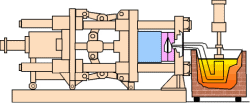The Cold Chamber Die Casting. Metals in various sizes and shapes are produced through many casting procedures and one of them is die casting. Zinc Die casting produces durable alloy in different shapes and can be produced in many identical pieces. The procedure requires machines with molds or dies where the molten alloy is placed and solidified. The alloys usually used in die casting are aluminum, zinc, copper, magnesium, tin, and lead. They have different metallurgical properties and they can be used depending on their properties.
There are two methods in die casting: hot-chamber and cold-chamber die casting. Metals with low melting point can be placed in hot chamber machines while those with high melting point can be placed in cold-chamber machines. Also, the difference between the two is the main process in which the alloys are produced.
In cold chamber die casting, the alloys are melted in a furnace separated from the machine. When the alloys are already melted, they are transferred to the dies through the use of hydraulic or mechanical piston. In the cold die chamber, the alloys are quickly hardened. One of the disadvantages of using the cold chamber die casting is the longer time needed for the alloys to be formed because of the additional time for transferring the alloys to the chamber. A ladle is used to transport the molten metal from the furnace to the cold chamber. The ladle can be manual or automatic in terms of operation.
Examples of alloys that can be used in cold chamber are aluminum, magnesium, and copper.
-
DieCastingZinc Company
American Die Casting Company
located in
Los Angeles, California USA
United States of America - Questions or Prices:
Sales@DieCastingZinc.com Die Casting Zinc Blog
Zinc Die Casting
-

Hot Chamber Zinc
Die Casting Machine Archives
